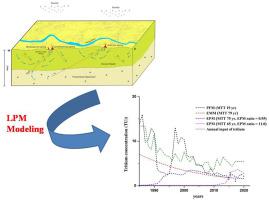Applied Geochemistry ( IF 3.1 ) Pub Date : 2021-08-17 , DOI: 10.1016/j.apgeochem.2021.105076 Sitangshu Chatterjee 1, 2 , Archana S. Deodhar 1 , Uday K. Sinha 1 , Bishnu P. Biswal 3

|
Constraining the mean transit time (MTT) of thermal waters is essential to understand the sustainability and renewal rate of geothermal systems. In this study, tritium concentrations of samples from five thermal water manifestations, three shallow groundwater wells (dug wells) and one deep groundwater (borehole) are analysed at regular time intervals for three years to estimate the MTT of the thermal and non-thermal waters in the Deccan Volcanic geothermal province by using lumped parameter models. The tritium concentrations of the thermal waters are found to vary between 0.77 and 2.77 TU (±0.0.23 TU at 1σ) which are lower than those of the shallow non-thermal groundwater (5.4–7.18 TU) (±0.40 TU at 1σ) whereas the tritium value for the deep groundwater ranges between 2.30 and 2.78 TU (±0.27 TU at 1σ). Among different lumped parameter models, PFM (piston flow model), EMM (exponential mixing model) and EPM (exponential piston flow model) are used to estimate the MTT of the groundwater and thermal waters in the study area. The historical records of weighted mean concentration of tritium in precipitation at the nearby Tural-Rajwadi geothermal area is taken as input function in the modelling procedure. The PFM and EMM models represent the lower and upper case of the EPM model mixing, respectively whereas the values obtained from the EPM models provide the actual range of mean transit times. The overall uncertainty in the MTT estimation has also been computed. The MTT of the younger fraction of the thermal waters in Ganeshpuri thermal water (HS-1) and Akloli thermal water (HS-7) are found to be 70 ± 5 and 90 ± 14 years old respectively. The MTT of both the shallow groundwater (DW-1 and DW-3) samples is estimated to be ~1.5 years whereas the MTT of the deep groundwater (BH-1) is 39 ± 6 years. Thermal springs in this area undergo mixing with non-thermal water during its ascent towards the surface as a result binary mixing model has been applied to find the MTT of the mixed thermal spring. The aggregate MTT of HS-1 turns out to be 7860 ± 870 years. This study of MTT estimation can be used for accessing the sustainability and renewability of these thermal waters compared to other thermal areas in Deccan volcanic region.
中文翻译:

使用氚示踪剂限制印度德干火山地热区相对现代热水的平均传输时间 (MTT)
限制热水的平均传输时间 (MTT) 对于了解地热系统的可持续性和更新率至关重要。在这项研究中,对来自五个热水表现形式、三个浅层地下水井(挖井)和一个深层地下水(钻孔)的样品的氚浓度进行了三年的定期分析,以估计热水和非热水的 MTT在德干火山地热省使用集总参数模型。发现热水的氚浓度在 0.77 和 2.77 TU(±0.0.23 TU at 1σ)之间变化,低于浅层非热地下水(5.4-7.18 TU)(±0.40 TU at 1σ)而深层地下水的氚值介于 2.30 和 2.78 TU 之间(±0.27 TU at 1σ)。在不同的集总参数模型中,PFM(活塞流模型)、EMM(指数混合模型)和EPM(指数活塞流模型)用于估计研究区地下水和热水的MTT。附近图拉尔-拉杰瓦迪地热区降水中氚加权平均浓度的历史记录作为建模程序的输入函数。PFM 和 EMM 模型分别代表 EPM 模型混合的下限和上限情况,而从 EPM 模型获得的值提供了平均传输时间的实际范围。还计算了 MTT 估计中的整体不确定性。发现 Ganeshpuri 温泉水 (HS-1) 和 Akloli 温泉水 (HS-7) 中较年轻部分的 MTT 分别为 70 ± 5 和 90 ± 14 岁。浅层地下水(DW-1 和 DW-3)样本的 MTT 估计为~1.5 年,而深层地下水(BH-1)的 MTT 为 39±6 年。该地区的温泉在上升到地表时会与非温泉水混合,因此已应用二元混合模型来计算混合温泉的 MTT。HS-1 的总 MTT 为 7860 ± 870 年。与德干火山区的其他热区相比,这项 MTT 估计研究可用于获取这些热水的可持续性和可再生性。该地区的温泉在上升到地表时会与非温泉水混合,因此已应用二元混合模型来计算混合温泉的 MTT。HS-1 的总 MTT 为 7860 ± 870 年。与德干火山区的其他热区相比,这项 MTT 估计研究可用于获取这些热水的可持续性和可再生性。该地区的温泉在上升到地表时会与非温泉水混合,因此已应用二元混合模型来计算混合温泉的 MTT。结果表明 HS-1 的总 MTT 为 7860 ± 870 年。与德干火山区的其他热区相比,这项 MTT 估计研究可用于获取这些热水的可持续性和可再生性。











































 京公网安备 11010802027423号
京公网安备 11010802027423号